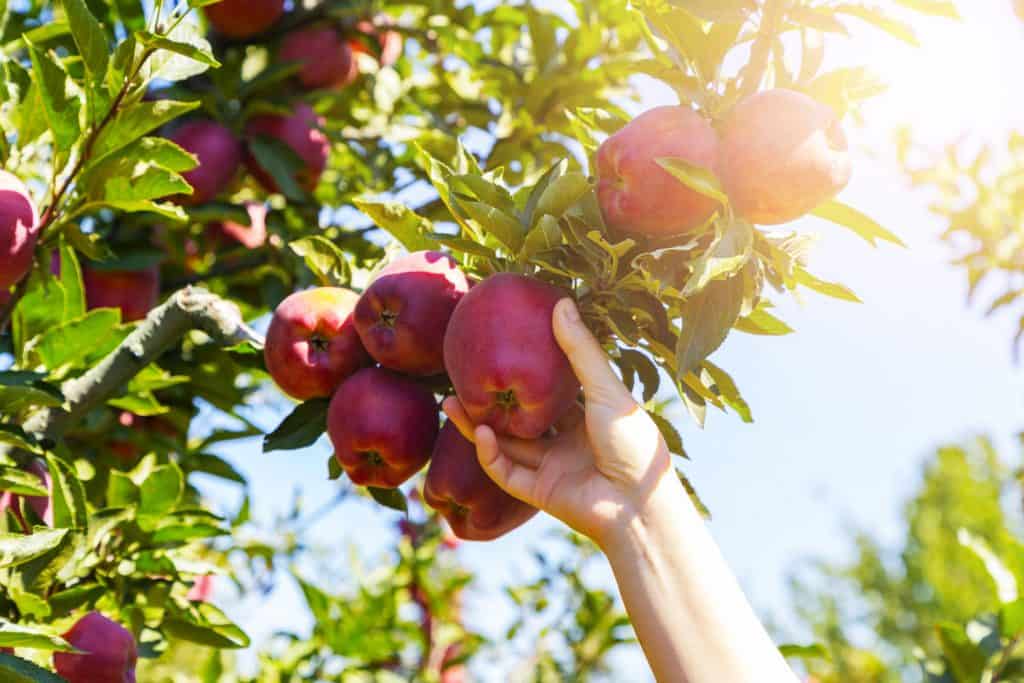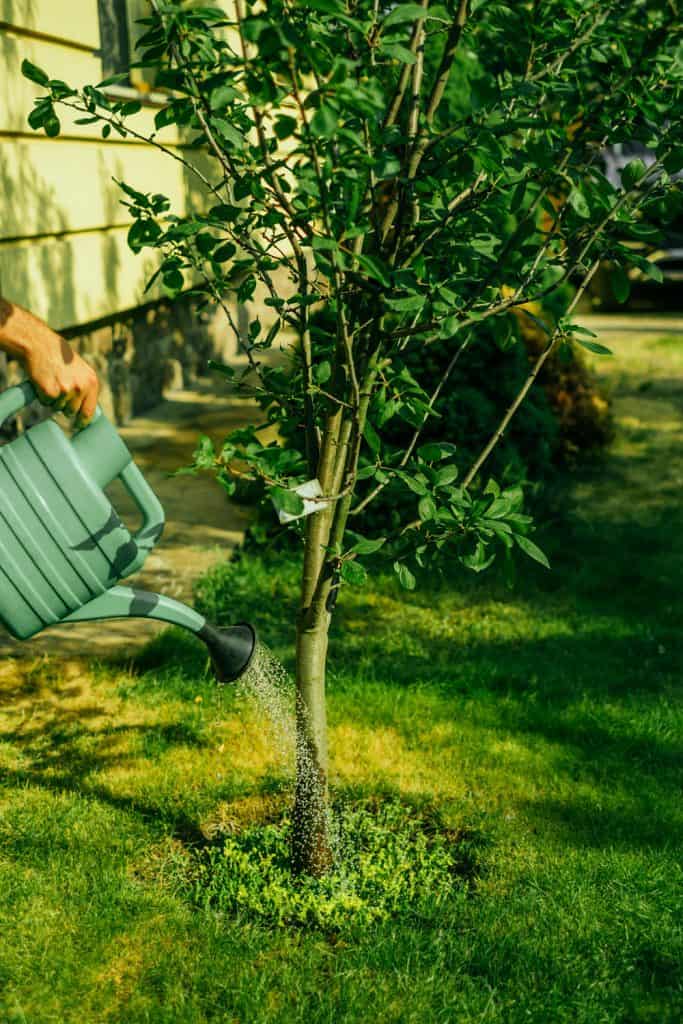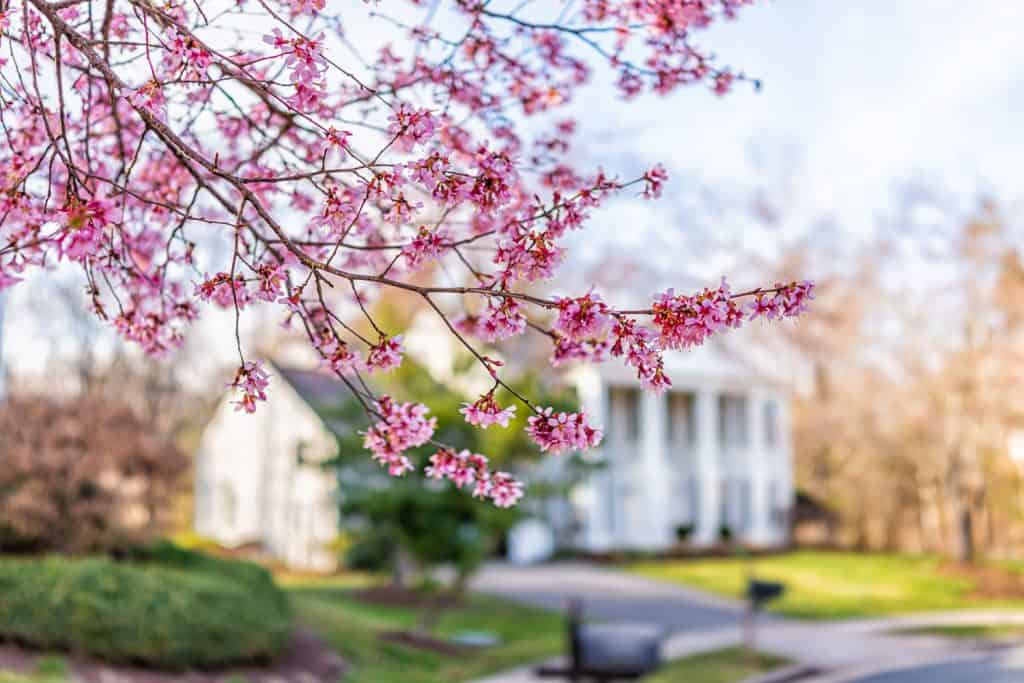No matter the type, growing fruit trees is a rewarding process that can produce a yearly bounty. However, achieving the best results requires a solid understanding of tree soil condition needs. So you are wondering how much fertilizer to give to your fruit trees. In this post, we have pulled together our research to answer your question thoroughly.
The specific amount of fertilizer needed by your tree depends on several different factors. These factors include the following:
- Soil conditions
- Nutrient levels
- pH level
- Tree species
- Season of the year
- Tree age
- Fertilizer type
Keep reading the rest of this post for details on each of the above fertilizer quantity considerations. This guide will teach you how to assess the quality of your tree's soil and will give you the tools needed to determine the best way to fertilize. We also include a guide on how specifically to fertilize fruit trees.

Contents
How much fertilizer does a tree need?
For centuries, this question has prompted curiosity from gardeners and horticulturists alike. This curiosity has fueled a great deal of information on how much fertilizer a tree needs. To make that information easy to understand, we have gathered it in the following sub-sections.
Soil Conditions
The first consideration when deciding how to fertilize a fruit tree is soil conditions. Different soil contains different levels of nutrients and soil acidity.
Click here for a multi-use at-home soil tester on Amazon.
To understand these levels, you must conduct a soil test. There are two main ways to conduct soil tests: at-home tests and sending your soil off to a local extension office.
Whichever of these techniques you choose, take the time to conduct a soil test as you consider fertilizing your trees.
Nutrient Levels
For nutrients, you are looking for a balance of the three main nutrients of nitrogen, phosphorus, potassium, and a few micronutrients. The tests will tell you if you are high or low in any of the specific nutrients.
Click here for an at-home soil test from Amazon.
If your soil test comes back with any of these nutrients as low, you will know to put on extra for that specific element. For instance, if you have a low nitrogen level, you will apply a fertilizer with higher nitrogen content.
Understanding the nutrient content of fertilizer is a simple process once you know the trick. All you do is look at the three numbers separated by dashes on the fertilizer packaging.
These numbers stand for N-P-K, or nitrogen, phosphorus, and potassium. Therefore, if you have low nitrogen soil, you will be advised to buy a fertilizer with a higher first number, such as a 10-5-5.
Micronutrients
In addition to the N-P-K levels on most fertilizers, fruit trees need a bevy of other micronutrients such as calcium, magnesium, iron, sulfur, and others.
Click here for a calcium magnesium fertilizer on Amazon.
Often but not always, professional soil tests or even at-home tests will measure your soil for calcium and magnesium. This helps you add these nutrients as needed.
Click here for a micronutrient fertilizer from Amazon.
However, if you fertilize for the main nutrients and still suspect nutrient deficiencies in your trees, it might be worth paying to test your soil for the other micronutrients. Alternatively, you can add special fertilizers that are full of all micronutrients in small doses.
pH Level
Similar to nutrients, trees prefer soil of a certain pH. The pH determines the acidity. A pH of over 8 is considered basic, and a pH below 6 is considered acidic. Generally, fruit trees prefer a relatively neutral acidity from a pH of 6 to 8.
Click here for a soil pH tester from Amazon.
If your soil is too acidic, consider adding lime or other fertilizer designed to decrease the pH. If your soil is too basic, consider adding fertilizers such as acidifying nitrogen or elemental sulfur.
Tree Species
Different fruit tree species require different nutrient levels. Generally, it is worth asking at a local nursery about your specific tree species and type. However, according to this article from Washington State University, all fruit trees need descent levels of N-P-K and magnesium and calcium.
Apple Trees

Like all fruit trees, Apple trees need N-P-K for growth and calcium and magnesium for their flowers and fruiting. If you notice that the leaves are struggling, add nitrogen. Add calcium and magnesium, f you find that the buds are not forming correctly. If the fruit is not properly developing, add potassium.
Tree Age
According to this article from the Oregon State University extension office, young fruit trees should be primarily fertilized with lime and phosphorus. After that, you will want to hold off on nitrogen fertilizers until the root system has fully established.

If you over-fertilize young trees, you run the risk of burning them with fertilizer. This causes the leaves to get dry and crispy and can even kill them.
Once the tree has fully established itself after 10-months or so, you can start fertilizing it regularly.
Fertilizer Type
While soil conditions are the first issue to consider when deciding how much fertilizer to put on the soil, the most important issue is the type of fertilizer you plan on applying.
Click here for a granular fruit tree fertilizer from Amazon.
Always follow the directions on the container. If the fertilizer is a powder or granular, the directions come for top amending the soil and mixing the fertilizer in with fresh soil. If the fertilizer is liquid, it is designed to be mixed with water and watered into the soil around your tree.
Adding more fertilizer than is suggested by your fertilizer brand WILL NOT cause your trees to do better. This may cause the soil to become oversaturated in nutrients, harming your tree and stunting growth and production.
Season of the Year
Nitrogen helps leaves grow, and potassium helps trees fruit. Therefore, it is more appropriate to put nitrogen fertilizer on in the spring and potassium as the tree begins to fruit. This shifts for different types of trees - the best resource is the experts at your local nursery.
When should you fertilize trees?
Generally, it is best to fertilize trees in early spring as the world begins to thaw. This coincides with late April to early May in most places in the US. However, the specifics do depend on the type of tree and your specific soil conditions.
What is the best time to fertilize a fruit tree?

Other than early spring, the best time to fertilize your trees is when you notice they have a nutrient deficiency. That is to say, if your tree needs fertilizer, do not wait until next spring to fix the nutrient problem.
How do you fertilize trees?
The first thing to keep in mind when fertilizing trees is following the fertilizer container's directions. Other than that, it is essential to keep the fertilizer off the trunk of the tree. The types of fertilizers are top-dressed, mix in, liquid, and spikes.
Top-Dress Fertilizer
Click here for a hand-held fertilizer spreader from Amazon.
Just spread an even layer over the ground with a fertilizer spreader or your gloved hand for top-dressed fertilizers. This is an easy way to apply fertilizer to mature and already planted fruit trees.
Mix In Fertilizer
Fertilizer that you mix into the soil is most commonly used when you are planting new trees. Mix the amendment into the soil as you prepare the area where the tree will be planted. Then, plant the tree into the fertilized area.
Liquid Fertilizer
For liquid fertilizers, you will want to mix the fertilizer in with your watering can at the specified proportions. Then, being careful not to get the mixture on the trunk or leaves, water the tree with the fertilizer.
Spike Fertilizers
Click here for spike fruit tree fertilizers from Amazon.
The final type of fertilizer is spike feeders. These are designed to be pushed into the ground near the tree's trunk, where they slowly release nutrients into the soil over time.
What is the best fertilizer for fruit trees?
There is no best fertilizer for fruit trees. The appropriate fertilizer depends on your soil type, your tree, and your local climate. Ask the experts at your local nursery about what fertilizers work well in your area to get a good starting point.
Click here for a fruit tree fertilizer from Amazon.
That being said, getting any standard fruit tree fertilizer will likely boost your tree's production and health. Further, it may be worth considering an organic fertilizer that is not full of potentially harmful chemicals. These fertilizers are clearly marked as organic on their labels.
In Closing
Garden Tabs has many great articles on growing and harvesting from fruit trees. Some of them are linked below!
- What Is The Best Time To Graft Fruit Trees?
- 7 Best Fertilizers For Crabapple Trees
- 11 Best Fruit Trees To Grow In Texas
In this post, we answered how much fertilizer to put on fruit trees, including apples. This includes a long list of considerations to think about when deciding on fertilizer quantity. We also include a quick guide on how to best apply different types of fertilizer. Good luck!









